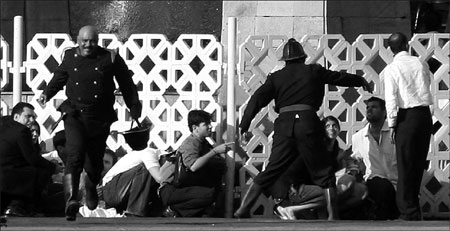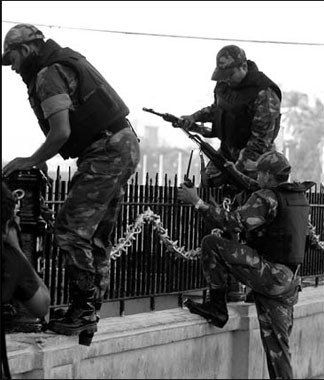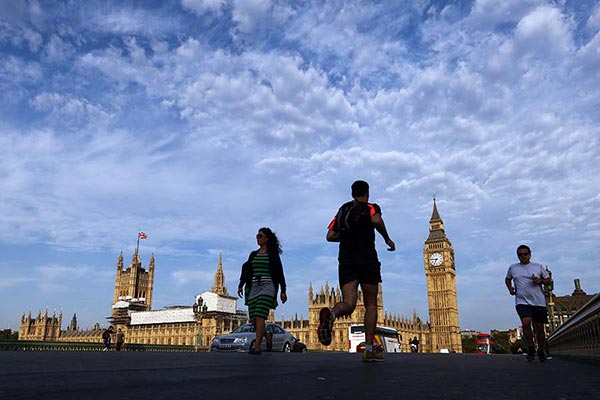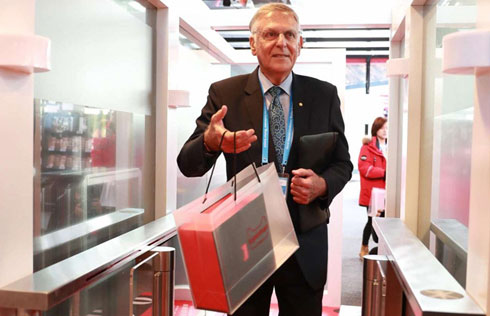Mumbai landmark becomes terror target
|
People duck as gunshots are fired from inside the Taj Mahal Hotel in Mumbai yesterday. |
They showed up on Wednesday, as they do every night: businessmen for meetings in the elegant restaurant that overlooks the harbor, politicians for cocktails in a bar with velvet seats and wood and marble floors, friends for a steak dinner by the pool.
But then the shooting started.
Explosions followed in and around the Taj Mahal Palace and Tower - a Mumbai landmark with sweeping staircases, onyx columns and high alabaster ceilings, known as the playground of the city's elite since it opened in 1903.
More than 100 people were killed in coordinated when the teams of gunmen stormed the Taj and another hotel, a popular restaurant, hospitals, a Jewish center, a crowded train station and at least five other sites. A group of suspected Muslim militants claimed responsibility.
At the Taj, anyone who could ran for cover.
Dalbir Bains, who runs a lingerie shop in Mumbai, had just sat down for dinner by the pool when she heard the first shots. She ran upstairs and huddled under a table in the Sea Lounge restaurant. She, and about 50 others who were with her, tried to remain as quiet as possible.
"The gun shots were following us," said Bains.
It wasn't until 4 am, more than six hours after the first shots rang out, that authorities began escorting people out of the hotel. That's when Bains climbed down a fire ladder to safety.
A handful of people sneaked out earlier, including a group guided by security personnel who happened to be dining at the hotel. They shuffled five at a time down more than 20 flights of stairs. Many took their shoes off to minimize the noise.
|
Army commandos take position at the Gateway of India near the Taj Hotel in Mumbai yesterday. Reuters |
The spiraling stairway was narrow and steep, and it was so hot they had to stop three times on the half-hour journey, said Manrico Iachia, the Italian executive vice-president of Europ Assistance, an insurance firm.
Two men carried a woman in a wheelchair down, he said.
"The most important thing is not to be injured," he said. "You are so close to freedom. But what does freedom mean if the bad guys are on the street waiting for you?"
Others were not so lucky. The gunmen were still believed to be holed up inside, holding as many as 15 foreigners hostage, said Anees Ahmed, a top state official.
From outside the hotel, people could be seen silhouetted in the windows of their hotel rooms, apparently unable to get past a fire that smoldered for hours and then erupted into flames shortly after 3 am.
Some raised their fists vainly against the glass; others flicked their lights on and off in distress. One man banged a large lamp against the window. A couple took turns waving a white flag.
Witnesses said about 200 people - hotel staff, diners at the Souk restaurant, and people attending an India-Korea business conference - hid together for five hours in a conference room at the top of the adjacent Taj Tower.
They drew the curtains and crouched under tables. Hotel staff passed around glasses of water.
Women were forced to urinate in ice buckets and men relieved themselves in the kitchen.
Police have not said how many died at the Taj, but at least one Japanese man is known to have been killed there, according to the Bombay Hospital. The hospital said nine Europeans from the hotel were admitted, three of them in critical condition with gunshot wounds.
Agencies
(China Daily 11/28/2008 page11)










